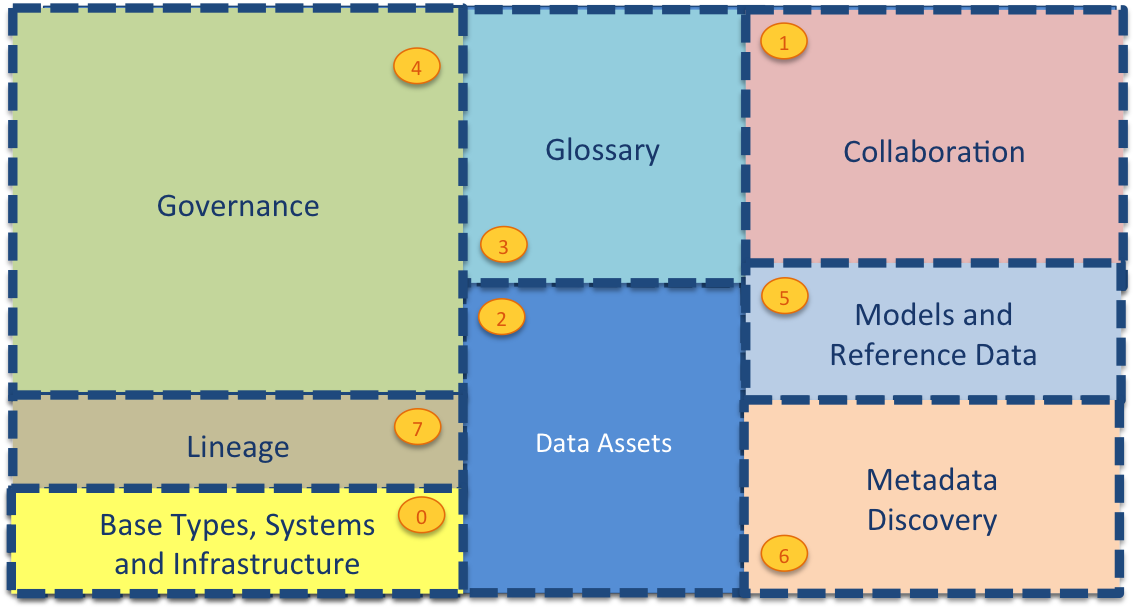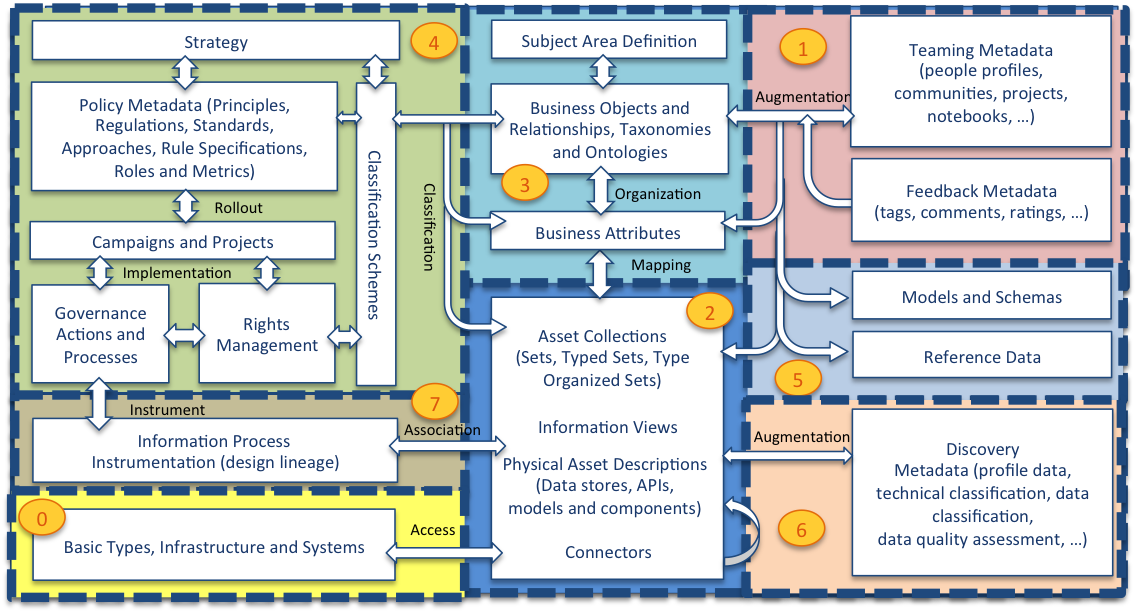The open metadata type system¶
Knowledge about data is spread amongst many people and systems. One of the roles of a metadata repository is to provide a place where this knowledge can be collected and correlated, as automated as possible. To enable different tools and processes to populate the metadata repository we need agreement on what data should be stored and in what format (structures).
Open metadata subject areas¶
The different subject areas of metadata that we need to support for a wide range of metadata management and governance tasks include:

This metadata may be spread across different metadata repositories that each specialize in particular use cases or communities of users.
| Area | Description |
|---|---|
| Area 0 | describes base types and infrastructure. This includes the root type for all open metadata entities called OpenMetadataRoot and types for Asset, DataSet, Infrastructure, Process, Referenceable, SoftwareServer and Host. |
| Area 1 | collects information from people using the data assets. It includes their use of the assets and their feedback. It also manages crowd-sourced enhancements to the metadata from other areas before it is approved and incorporated into the governance program. |
| Area 2 | describes the data assets. These are the data sources, APIs, analytics models, transformation functions and rule implementations that store and manage data. The definitions in Area 2 include connectivity information that is used by the open connector framework (and other tools) to get access to the data assets. |
| Area 3 | describes the glossary. This is the definitions of terms and concepts and how they relate to one another. Linking the concepts/terms defined in the glossary to the data assets in Area 2 defines the meaning of the data that is managed by the data assets. This is a key relationship that helps people locate and understand the data assets they are working with. |
| Area 4 | defines how the data assets should be governed. This is where the classifications, policies and rules are defined. |
| Area 5 | is where standards are established. This includes data models, schema fragments and reference data that are used to assist developers and architects in using best practice data structures and valid values as they develop new capabilities around the data assets. |
| Area 6 | provides the additional information that automated metadata discovery engines have discovered about the data assets. This includes profile information, quality scores and suggested classifications. |
| Area 7 | provides the structures for recording lineage and providing traceability to the business. |
The following diagram provides more detail of the metadata structures in each area and how they link together:
Metadata is highly interconnected

Bottom left is Area 0 - the foundation of the open metadata types along with the IT infrastructure that digital systems run on such as platforms, servers and network connections. Sitting on the foundation are the assets. The base definition for Asset is in Area 0 but Area 2 (middle bottom) builds out common types of assets that an organization uses. These assets are hosted and linked to the infrastructure described in Area 0. For example, a data set could be linked to the file system description to show where it is stored.
Area 5 (right middle) focuses on defining the structure of data and the standard sets of values (called reference data). The structure of data is described in schemas and these are linked to the assets that use them.
Many assets have technical names. Area 3 (top middle) captures business and real world terminologies and organizes them into glossaries. The individual terms described can be linked to the technical names and labels given to the assets and the data fields described in their schemas.
Area 6 (bottom right) captures additional metadata captured through automated analysis of data. These analysis results are linked to the assets that hold the data so that data professionals can evaluate the suitability of the data for different purposes. Area 7 (left middle) captures the lineage of assets from a business and technical perspective. Above that in Area 4 are the definitions that control the governance of all of the assets. Finally, Area 1 (top right) captures information about users (people, automated process) their organization, such as teams and projects, and feedback.
Within each area, the definitions are broken down into numbered packages to help identify groups of related elements. The numbering system relates to the area that the elements belong to. For example, area 1 has models 0100-0199, area 2 has models 0200-299, etc. Each area's sub-models are dispersed along its range, ensuring there is space to insert additional models in the future.
Understanding the models¶
The diagram above shows a few fragments from the models. Each of the UML classes represents an open metadata type. The stereotype on the UML class in the double angle brackets of entity, relationship and classification defines the category of the type. The line between entities with the big arrow head means "inheritance". A type points to its supertype.
The example on the left comes from model 0010
It shows that Asset inherits from Referenceable which inherits from OpenMetadataRoot. This means that Asset is a subtype of Referenceable, which is a subtype of OpenMetadataRoot. Alternatively, OpenMetadataRoot is the supertype of Referenceable, which is a supertype of Asset. This inheritance identifies which attributes (instance properties) are valid for an instance of a particular type since it is the aggregation of the attributes defined explicitly for the type and all of its supertypes.
For example, Asset has two attributes defined: name and description. It also supports qualifiedName and additionalProperties because they are inherited from Referenceable. OpenMetadataRoot does not have any attributes defined so Asset gets nothing from it.
The example on the right comes from model 0011
It shows the classification called Template that can be connected to a Referenceable. Since Referenceable is already defined in model 0010, it is shown without the white box where the attributes are show (called the "attribute container" in UML parlance).
SourcedFrom is a relationship that connects two instances of Referenceable and any of its subtypes. This means SourcedFrom could connect two instances of type Asset together. The types of the instances connected do not need to be the same - SourcedFrom could connect a Referenceable instance with an Asset instance.
The thickness of the relationship line indicates which relationships are uni-link or multi-link. A thin line indicates uni-link. Multi-link is represented by a thick line.
The UML model diagrams show the currently active types. Some types and attributes have been deprecated and these have been removed from the model diagrams. However, there is a description of the deprecated types and which of the active types to use instead. Although the deprecated types can be used (for backwards compatibility) it is always preferable to use the latest types since they are typically more efficient and more consistent than their predecessors.
Attribute type definitions¶
The properties defined on each open metadata type must be a defined attribute type. There are three choices:
- Primitives (described by PrimitiveDefs).
- Collections such as arrays and maps (described by CollectionDefs).
- Enumerations - that is lists of valid values (described by EnumDefs).
Primitives¶
The primitive defined in the open metadata types are:
objectbooleanbytecharshortintlongfloatdoublebigintegerbigdecimalstringdate
Collections¶
The collections defined in the opn metadata types are:
map<string,string>map<string,boolean>map<string,int>map<string,long>map<string,object>array<string>array<int>
Enumerations¶
The enumerations are defined with the open metadata types for entities, relationships and classifications.
Raise an issue or comment below